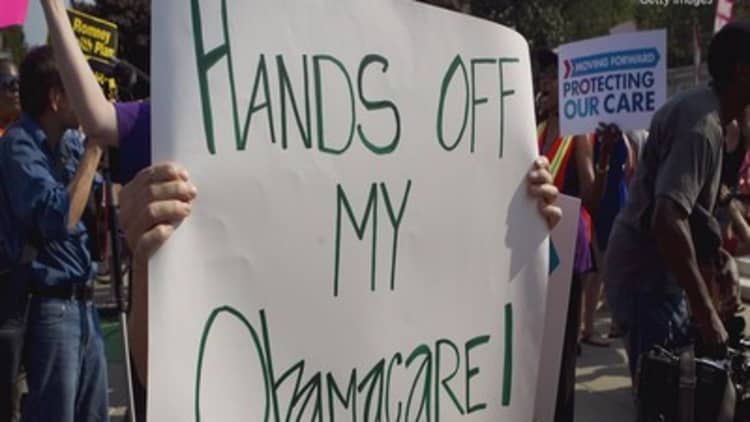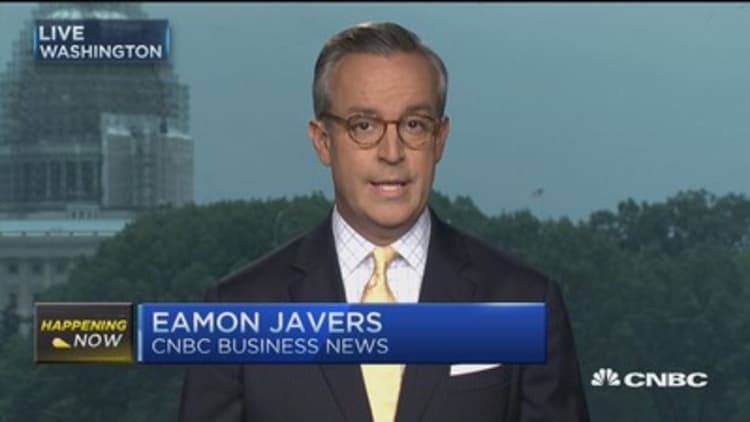
If U.S. states had a Facebook setting for Obamacare status, it would say: "It's complicated."
This month, that might change to: "It's very, very complicated."
The catalyst would be a Supreme Court ruling that could—for the second time in less than two years—cause a dramatic shift in the differences between states in their uninsured rates and in the financial burden on hospitals and other medical providers from caring for the uninsured.
That shift in turn could affect how attractive states appear to individuals and businesses looking to relocate. It also could exacerbate an ongoing situation in which some states effectively subsidize the health coverage of other states' residents and the bottom lines of medical providers.
Read MoreGuess who's spending billions to create US jobs
"This is kind of a make-or-break moment" for Obamacare, said Nick Ragone, spokesman for Ascension, the nation's largest nonprofit health system. "We're watching this very closely."
Before Obamacare began taking widespread effect in 2014, there were big differences between states in their uninsured rates—the percentage of people without health insurance. Nationally, the uninsured rate was approaching 19 percent for nonelderly adults.
At the low end of the scale were such states as Massachusetts, Hawaii, Minnesota, Delaware and Vermont, as well as the District of Columbia. All of them had uninsured rates of 10 percent or less for adults up to age 64, according to Kaiser Family Foundation data.
"All of those states had some kind of broad coverage expansions that they adopted for the Medicaid programs," said Jennifer Tolbert, director of state health reform for Kaiser. In other words, the states used their existing Medicaid programs, which are jointly run with the federal government, to increase the number of eligible poor and low-income people.
At the high end were states including Texas, Arizona, Florida and Nevada, all of which had uninsured rates for nonelderly adults higher than 25 percent. Tolbert said those states, like most other states at the time, had much tighter restrictions on who could receive Medicaid coverage.
But Tolbert also noted there were "lots of dynamics" that affected states' uninsured rates other than Medicaid.
Read MoreInside the Kansas tax cuts
"What you see is that states with higher poverty rates are going to have higher number of uninsured," she said. Another factor was the rate of employers offering health coverage to their workers, which tends to be higher in the North than in the South.
The Affordable Care Act, as written, was meant to tackle the uninsured rate through two key programs.
The first was the creation of government-run exchanges like HealthCare.gov, which sells private insurance to people whose income is above the poverty level, with no one denied coverage or charged more because of existing conditions.
Customers who earned less than four times the poverty level—which turned out to be nearly 90 percent of the exchanges' customers—were also eligible for federal subsidies to help offset the cost of their coverage.
The second major ACA program was the expansion of Medicaid eligibility to nearly all people whose income is below 138 percent of poverty.
A 2012 Supreme Court decision said that states could not be compelled under the ACA to expand Medicaid. But so far, 28 states and D.C. have expanded Medicaid, with Montana's proposed expansion awaiting federal approval.
Most of the people whose states have not expanded Medicaid live in the South.
Since Obamacare, private insurance exchanges began selling plans in 2014, and as Medicaid expansion took effect in more states, about 25 million have gotten coverage through one of these two provisions, as well as through another ACA program that allows people up to age 26 to stay on their parents' health plans.
Read MoreObamacare insurers get help for high-cost claims
As a result, "the uninsured rate has dropped across all states, regardless of whether they have expanded Medicaid or not," Tolbert said.
But, she added, "we've seen a much bigger drop in the uninsured rates among the states that have adopted Medicaid expansion."
State-by-state uninsured-rate data are not yet available, although it is expected to be released later this year.
At the same time that the overall uninsured rate dropped, so did the costs of providing care to people who lacked insurance.
But again, there was a significant difference in outcomes between the states that expanded Medicaid and those that didn't.
Last month, the federal government said "uncompensated care costs" that hospitals nationally incurred in 2014 were $7.4 billion lower than they would have been if insurance coverage had remained at 2013 levels.
However, the lion's share of those savings—$5 billion—came from states that expanded Medicaid.
Read More9 states considering Connecticut's Obamacare fix
A report issued in late April by the Kaiser Family Foundation looked at the experience of Ascension Health, which operates 131 acute-care hospitals and more than 30 senior-care facilities. Ascension's facilities are located in the District of Columbia and seven states that expanded Medicaid, along with nine states that did not expand.
"Overall, [Ascension] hospitals in Medicaid expansion states saw increased Medicaid discharges, increased Medicaid revenue and decreased cost of care for the poor, while hospitals in nonexpansion states saw a very small increase in Medicaid discharges, a decline in Medicaid revenue and growth in cost of care for the poor," the report said.
In a line item that contributed to that finding, Ascension hospitals in expansion states saw a 40.1 percent decrease in charity-care costs alone. That compares with a drop of just 6.2 percent in charity-care costs for Ascension facilities in nonexpansion states.
A market in transition
The findings underscore the disparities that persist between individual states even in the Obamacare era.
And those disparities could become more pronounced this summer. In some cases, states could revert to what was seen before Obamacare.
The Supreme Court this month is expected to issue a decision in a case known as King v. Burwell. In that case, plaintiffs claim that the subsidies that nearly all Obamacare exchange customers receive cannot be issued to customers of HealthCare.gov, the federally run insurance marketplace that serves two-thirds of the nation.
That claim is based on the argument that the Affordable Care Act does not explicitly authorize subsidies for customers of a federal exchange as it does for customers of state-run exchanges.
Read MoreCivil war in the American workplace
While the Obama administration disputes that interpretation and has asked the Supreme Court to reject it, few people on either side debate the potential effect of a ruling for the plaintiffs.

The Urban Institute has estimated that 8.2 million or so people in 34 states served by HealthCare.gov would become uninsured as a result of such a ruling.
"More than 6 million people [in HealthCare.gov states] currently receive a subsidy. Most of them would no longer be able to afford insurance," said Sara Collins, vice president for health-care coverage and access at the Commonwealth Fund.
"But it's also creating a very chaotic insurance market where premiums spiral up, which make premiums unaffordable for even people who might have been buying before the law went into effect," Collins said. In other words, even some people who were not being subsidized would drop their individual insurance plans as retail premium prices rise by an estimated 47 percent or more in HealthCare.gov states.
As a result, "the uninsured rate would climb up in those states," Collins said.
Collins said that ruling for the plaintiffs would have the most dramatic impact, in terms of increasing the uninsured rate and the cost of uncompensated care, in states that did not set up their own Obamacare exchange and that did not expand their Medicaid programs.
"You could potentially create a scenario where you have more people uninsured in Florida than you did prior to the ACA," Collins said. Other nonexpansion states that are served by HealthCare.gov, most prominently Texas, likewise could see uninsured rates that were higher than in the pre-Obamacare era.
Conversely, states that run their own exchanges and have expanded Medicaid would not be expected to have their uninsured rate rise.
In between would be the states that are on HealthCare.gov but which have expanded Medicaid, a group that includes Ohio, Indiana, Pennsylvania and New Jersey. Those states would see many individual-plan insurance customers drop coverage but would retain newly eligible Medicaid enrollees.
Collins said a ruling for the plaintiffs "not only creates havoc in the insurance market, it also means that hospitals and other providers just don't have that revenue anymore" from the newly insured, she said. Uncompensated care costs would be expected to rise in HealthCare.gov states as a result.
Finally, a ruling for the plaintiffs would lead to affected states incurring costs from Obamacare while getting much less of the benefits.
The federal government through 2016 is paying 100 percent of the costs of insuring newly eligible people under the Medicaid expansion program. After that, the federal government's contribution to the funding tapers down, but to no less than 90 percent of costs. The estimated cost of that program to the federal budget is $847 billion from 2016 through 2025, according to the Congressional Budget Office. Individual states, on the other hand, are expected to pay just $46 billion in extra costs during that same time span as a result of Medicaid expansion.
The federal government's spending on Medicaid expansion is financed by taxpayer revenue—that is, the taxes collected from residents in each state. So people in non-Medicaid expansion states are paying for the costs of the program while receiving no coverage or money from the federal government to pay providers for caring for enrollees in the program.
Likewise, if the Supreme Court rules for the plaintiffs in the King case, people in HealthCare.gov states would no longer be eligible to receive Obamacare subsidies, and medical providers would conceivably get less business from those customers. But the residents would continue paying taxes that in turn would be used to subsidize Obamacare customers in states that are running their own insurance exchanges.
"That would be the same dynamic," Collins said. "It just exacerbates the outflow of tax revenue from state residents."






